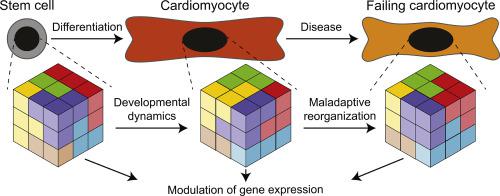Journal of Molecular and Cellular Cardiology ( IF 5 ) Pub Date : 2020-11-24 , DOI: 10.1016/j.yjmcc.2020.11.008 Alessandro Bertero 1 , Manuel Rosa-Garrido 2

|
Recent technological advancements in the field of chromatin biology have rewritten the textbook on nuclear organization. We now appreciate that the folding of chromatin in the three-dimensional space (i.e. its 3D “architecture”) is non-random, hierarchical, and highly complex. While 3D chromatin structure is partially encoded in the primary sequence and thereby broadly conserved across cell types and states, a substantial portion of the genome seems to be dynamic during development or in disease. Moreover, there is growing evidence that at least some of the 3D structure of chromatin is functionally linked to gene regulation, both being modulated by and impacting on multiple nuclear processes (including DNA replication, transcription, and RNA splicing). In recent years, these new concepts have nourished several investigations about the functional role of 3D chromatin topology dynamics in the heart during development and disease. This review aims to provide a comprehensive overview of our current understanding in this field, and to discuss how this knowledge can inform further research as well as clinical practice.
中文翻译:

心脏发育和疾病中的三维染色质组织
最近染色质生物学领域的技术进步改写了核组织的教科书。我们现在意识到染色质在三维空间(即它的 3D“架构”)中的折叠是非随机的、分层的和高度复杂的。虽然 3D 染色质结构部分编码在一级序列中,因此在细胞类型和状态中广泛保守,但基因组的很大一部分在发育或疾病期间似乎是动态的。此外,越来越多的证据表明,染色质的至少一些 3D 结构在功能上与基因调控相关,两者都受到多个核过程(包括 DNA 复制、转录和 RNA 剪接)的调节和影响。最近几年,这些新概念促进了有关 3D 染色质拓扑动力学在心脏发育和疾病过程中的功能作用的多项研究。本综述旨在全面概述我们目前在该领域的理解,并讨论这些知识如何为进一步的研究和临床实践提供信息。



























 京公网安备 11010802027423号
京公网安备 11010802027423号